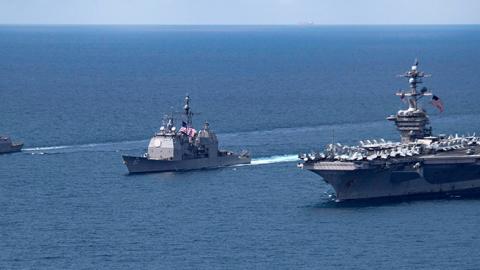Campaign promises are pesky things. President Donald Trump is finding it difficult to deliver on his promise to increase the size of the Navy from 275 ships today to an eventual 350 ship fleet (as part of a general increase in military spending). Like any presidential candidate, Trump made many promises on the campaign trail, the overwhelming majority of which will never be realized. Some campaign promises are plain falsehoods, some represent policy ends for which there is not sufficient Congressional support, some are prioritized lower than others due to scarce political capital, and some represent tent-pole priorities of an administration. After the release of the administration's FY 2018 budget this week, many are wondering where the 350 ship Navy fits. The answer? It is too soon to tell.
Radio talk-show host Hugh Hewitt has been active on Twitter and editorializing elsewhere that the promise has already been broken, citing the reporting of Sydney Freedberg of the inconvenient fact that the budget does not grow the Navy any faster than the outgoing Obama administration had planned. David Axe also wonders about Trump’s dedication to his promise, pointing (appropriately) to near term investments in workforce and plant capacity that would need to be made to enable the growth Trump desires. Such broad-based criticism of the budget’s dedication to the campaign’s shipbuilding commitments appears to have influenced the White House to add an additional littoral combat ship (LCS) the day after the budget was submitted — a sign of nervousness over the reaction to the plan.
These reactions — though based on facts — are premature. First, it does not appear that Trump as candidate or president publicly laid out a timeline for a 350 ship Navy. Recent fleet architecture work envisioning a similar sized fleet (I was a contributor) projected that it would take decades to build it, absent a national emergency. Given the long-term nature of the project, there need not be an immediate increase in shipbuilding.
Next, the immense costs associated with a buildup of this magnitude must be reconciled within the context of the larger budget — which itself must be placed within an overarching approach to governing the country. That approach has yet to manifest itself clearly, nor have the resources been identified to fund the administration’s other priorities. The Trump administration’s glacially slow start means that large-scale, visionary efforts like a naval expansion are held hostage to more prosaic matters such as staffing, planning, and damage control.
Additionally, no one observing Washington today should minimize the impact that two men have on building a larger Navy: Secretary of Defense Jim Mattis and Director of the Office of Management and Budgeting Mick Mulvaney. Mattis assumed office and within weeks released a set of budgetary priorities, the first of which was addressing serious short-term readiness issues. Growth of the force was relegated to his third priority, and would not begin in earnest until 2019 budget, once it could be aligned with a national security strategy to be produced in 2018. Mulvaney, on the other hand, is a known fiscal hawk from his days in the House of Representatives where he grew quite comfortable with both the Budget Control Act of 2011 and its demon spawn, sequestration. And, while the 2018 budget does not make the Navy larger, it addresses Mattis’ priorities by directing more money to ship maintenance as well as ship and air wing operations. It also funds a number of lethality upgrades in several Navy weapons accounts.
Taking all of this into account, it would be unfair to call the president’s 350 ship Navy promise “a lie” or “already sunk.” The Department of Defense is doing exactly what Mattis said it would do: Any growth of the force will follow efforts to shore up fundamental readiness issues. However, the next 12 months should be watched closely for signs that impending decisions on strategy, personnel, and resource allocation will benefit America’s fleet, or not.
First and most importantly, the National Defense Strategy effort underway in the Pentagon — chronicled deftly in these pages by Shawn Brimley — will reveal the degree to which the military applications of American seapower are valued by the administration, and the uses and places that power will be applied. Observers should look to the rhetoric coming out of the Defense Department in the year ahead to see if a compelling “seapower narrative” develops and is amplified by well-qualified and credible spokesmen. To be blunt, the president needs a better reason for a 350 ship Navy than his desire to command one. The administration should make the case for relieving the taxpayers of a good bit more of their hard-earned dollars to fund a significantly larger Navy. And the president and his administration will then have to put their weight behind it.
Nearly as important as the energetic support of the president will be the nomination of a secretary of the Navy. Thus far, the process does not augur well for naval expansionists. Early hopes that former House Armed Services member and seapower advocate Randy Forbes would get the job dimmed first with the nomination (subsequently withdrawn) of Philip Bilden, followed by considerable Washington chatter about banker Richard V. Spencer as the favorite. Spencer and Bilden are accomplished individuals, but neither has a strong background in seapower — which may in fact, be exactly the kind of service secretary that Mattis wants as a means of diminishing the services as independent power bases. Meanwhile, because neither the president nor the secretary of defense has the time to relentlessly advocate for the resources necessary to build the 350 ship Navy, the job must fall to the secretary of the Navy. If the 350 ship Navy is to be an administration priority, it cannot be guided by a Navy secretary occupying a sinecure. The job must be filled by a credible, eloquent, and able spokesman for the benefits seapower confers upon the nation and criticality of increasing the size of the Navy in the face of growing great power competition.
Finally, defense policymakers should be wary of “get big quick” schemes. These approaches include attempts to reclassify platforms currently not counted (due to size or mission) or that advocate for pulling ships out of the mothball fleet. There are good reasons to review what platforms get counted and why — a process that a new Navy secretary should immediately begin in cooperation with Capitol Hill. But simply reclassifying platforms as battle force ships raises the stench of manipulation for political purposes. As for pulling ships out of the “ghost fleet,” one rarely hears anyone who served on those ships in their waning years crying out for their recommissioning. The Navy mothballed those ships (primarily early Ticonderoga Class Cruisers and Oliver Hazard Perry Class Frigates) for good reasons, including their deteriorated material condition and looming high modernization cost. While their hulls may have corroded while they sat oxidizing in seawater, the reasons for mothballing them remain sound.
Perhaps the best possible outcome would be a long-term shipbuilding plan that adds ships in FY 2019 and beyond to hot production lines, accelerates future surface combatant design and acquisition, and retains and modernizes ships still in service that can be extended far beyond their current planned end of service lives.
Seapower advocates looking for a fleet expansion should not yet lose hope, as it appears the Trump administration is wisely and methodically taking the first steps toward sustained growth. But navies grow slowly, and effort must be sustained across many years, requiring sustained presidential leadership and attention. Whether this can be expected of the current president remains to be seen.














